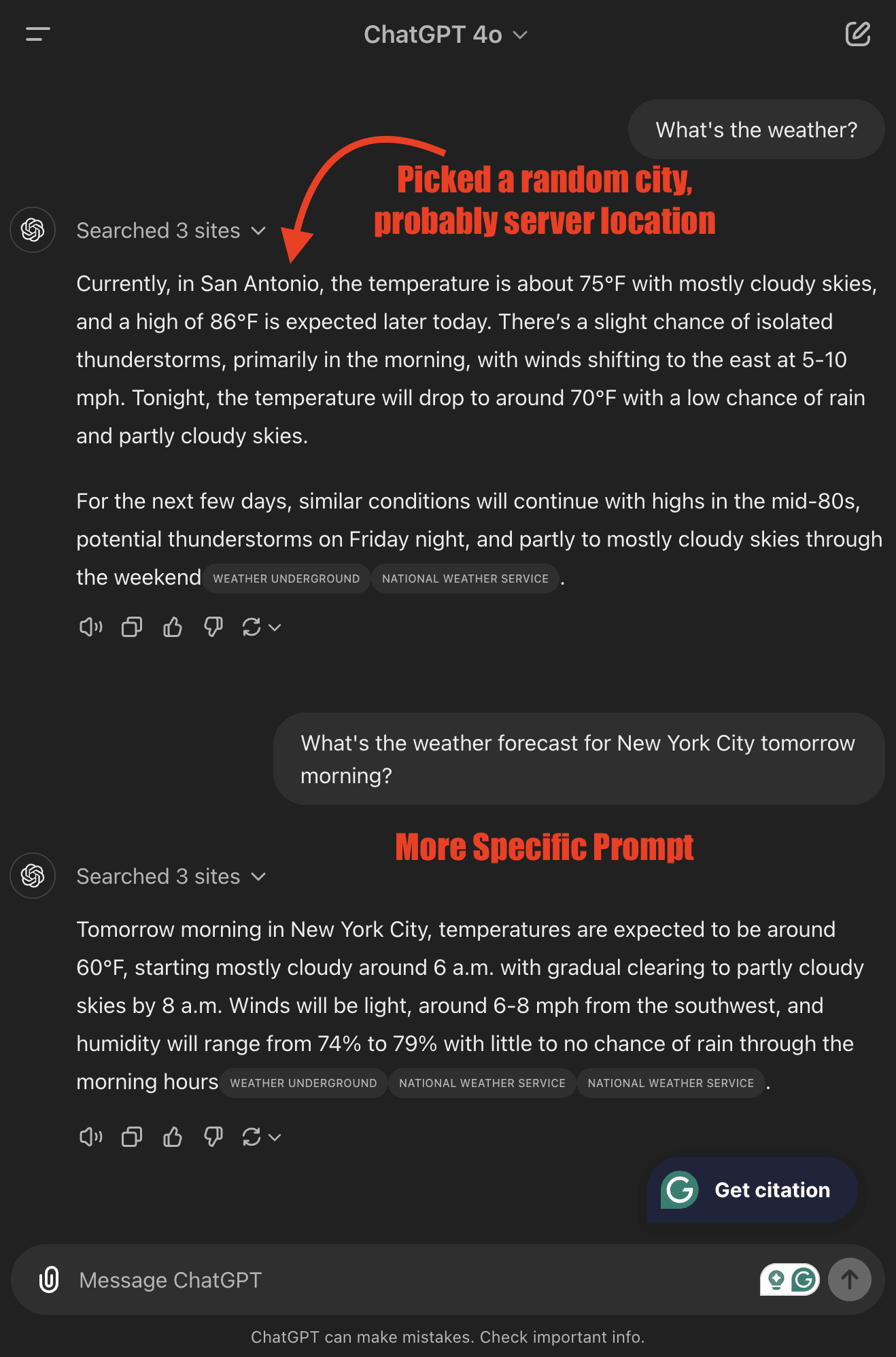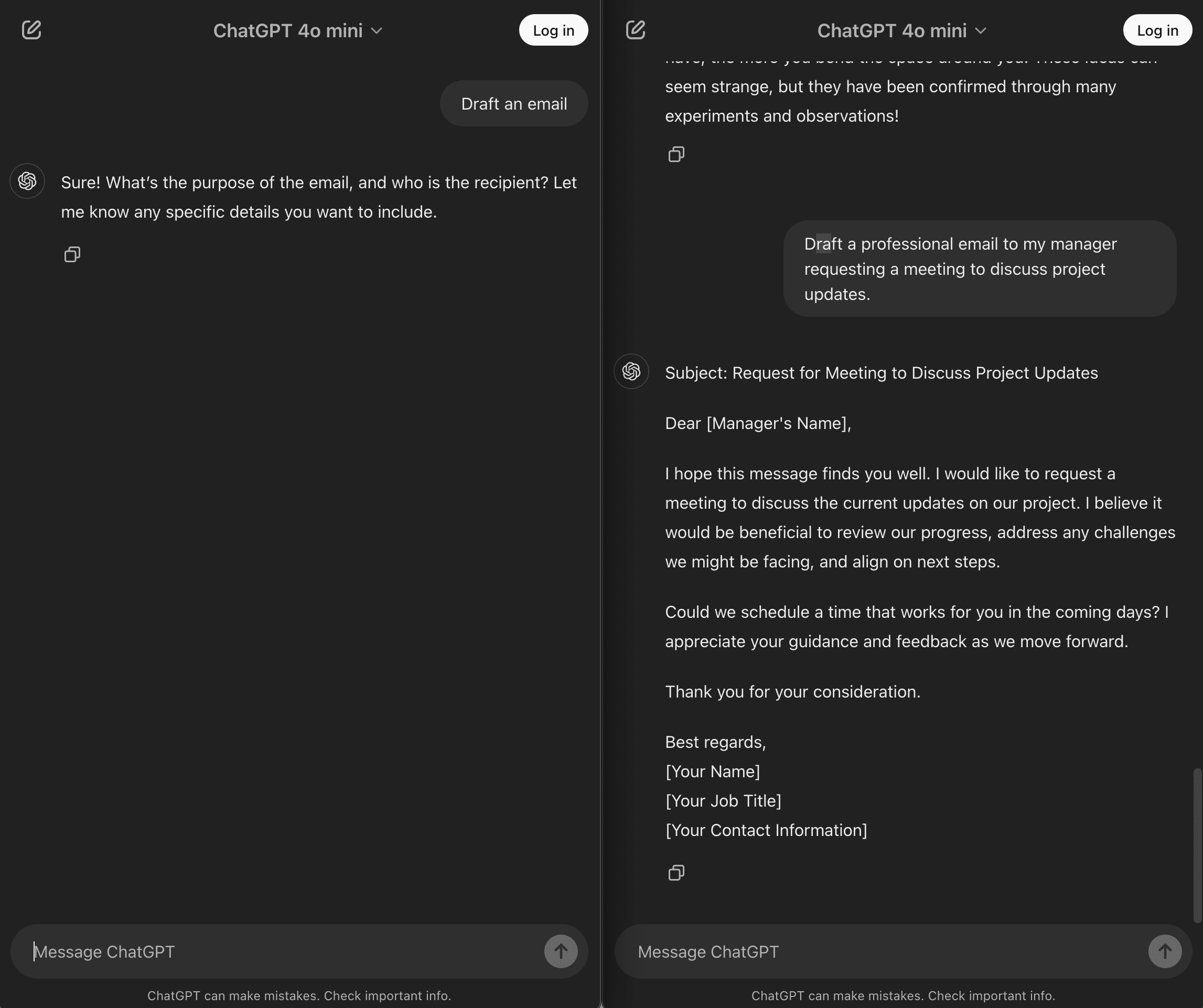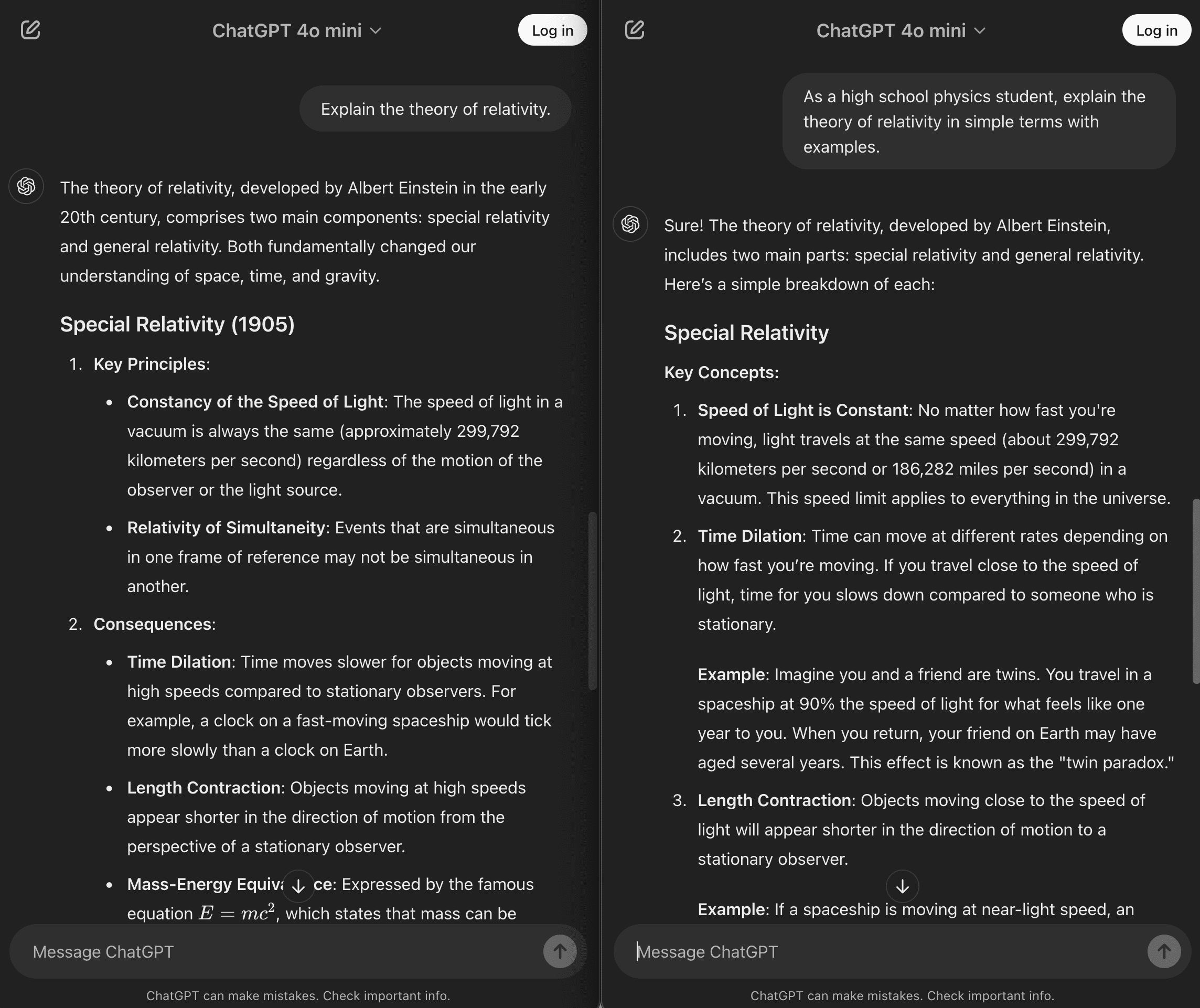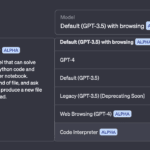Picture this: It’s late at night, and you’re wrestling with a pressing question. Aware that prompt engineering is crucial for extracting precise answers from AI, you decide to consult an AI assistant—after all, it’s supposed to have the solutions you seek, right? You type in your query: “Tell me everything about history.” You hit enter, and the AI responds with a brief paragraph that barely scratches the surface. Frustrated, you wonder why it didn’t provide the comprehensive answer you were hoping for.
But then it hits you—the way you phrase your question matters. This time, applying the principles of prompt engineering, you ask, “Can you provide a detailed overview of the major events during the Renaissance period in Europe, focusing on the cultural and scientific advancements?” Suddenly, the AI floods you with rich information, covering art, literature, science, and key historical figures.
What’s the difference between these two scenarios? The secret lies in prompt engineering. Welcome to a journey where you’ll learn to unlock the true potential of AI by mastering the art of crafting the perfect prompt. By the end of this adventure, you’ll not only communicate effectively with AI but also harness its capabilities to the fullest.
What is Prompt Engineering?
Definition
So, what exactly is prompt engineering? In the simplest terms, it’s the practice of designing and refining the questions or commands (prompts) you give to an AI to elicit the most accurate and helpful responses. Think of it as learning to speak a new language—a language that bridges human thought and machine understanding.
Imagine you’re trying to find a book in a vast library. If you ask the librarian, “I want a book,” you’ll likely receive a puzzled look. But if you specify, “I’m looking for a mystery novel set in Victorian London with a strong female protagonist,” the librarian can quickly pinpoint exactly what you need. Prompt engineering works the same way with AI.
Why It’s Important
In today’s AI-driven world, the ability to communicate effectively with machines isn’t just a neat trick—it’s a vital skill. A well-crafted prompt can:
- Save Time: Get precise answers quickly without going back and forth.
- Enhance Productivity: Use AI tools more efficiently in your work or studies.
- Improve Outcomes: Whether you’re coding, writing, or problem-solving, better prompts lead to better results.
Consider AI as a highly capable assistant waiting for your instructions. The quality of its work depends largely on how well you convey what you need.
Applications in Real Life
Prompt engineering isn’t confined to tech giants or AI enthusiasts; it’s woven into everyday life in more ways than you might realize.
- Customer Service Chatbots: Businesses use AI to handle customer inquiries. Effective prompts ensure customers get the right information promptly.
- Virtual Personal Assistants: Siri, Alexa, and Google Assistant rely on your prompts to perform tasks—from setting reminders to controlling smart home devices.
- Educational Tools: Students use AI for research assistance, language translation, and learning new subjects.
- Content Creation: Writers and marketers generate ideas, draft content, and even create entire articles with AI assistance.
- Programming and Development: Coders get help with debugging, code suggestions, and learning new programming languages.
The Foundations of a Good Prompt
To become a prompt engineering maestro, you need to understand the fundamental elements that make a prompt effective. Let’s break them down.
Clarity
Be Clear and Concise. Ambiguity confuses AI models just as it does humans.
Real-Life Scenario:
- Vague Prompt: “Tell me about plants.”
- Result: A generic overview of plants.
- Clear Prompt: “Explain the process of photosynthesis in plants and its importance to the Earth’s ecosystem.”
- Result: A detailed explanation focusing on photosynthesis and its ecological significance.

Specificity
The More Specific, the Better. Narrowing down your request helps the AI provide a focused response.
Real-Life Scenario:
- General Prompt: “What’s the weather?”
- Result: Weather information, but where?
- Specific Prompt: “What’s the weather forecast for New York City tomorrow morning?”
- Result: Precise weather details for the specified location and time.

Context
Provide Background Information if Needed. Context helps the AI understand the framework of your request.
Real-Life Scenario:
- Without Context: “Explain the theory of relativity.”
- Result: A general explanation.
- With Context: “As a high school physics student, explain the theory of relativity in simple terms with examples.”
- Result: A simplified explanation suitable for a high school student, including examples.
 Intent
Intent
Make Your Objective Obvious. Clearly state what you’re looking to achieve.
Real-Life Scenario:
- Unclear Intent: “Draft an email.”
- Result: An email, but about what?
- Clear Intent: “Draft a professional email to my manager requesting a meeting to discuss project updates.”
- Result: A well-crafted email suited for the intended purpose.

Table 1: Elements of a Good Prompt with Examples
| Element | Poor Example | Improved Example |
|---|---|---|
| Clarity | “Tell me about music.” | “Describe the evolution of jazz music in the 20th century.” |
| Specificity | “What’s a good diet?” | “What are some high-protein, low-carb diet options for vegetarians?” |
| Context | “Explain calculus.” | “As a college freshman struggling with math, explain the basics of differential calculus.” |
| Intent | “Help me write something.” | “Help me write a persuasive essay arguing for renewable energy adoption in urban areas.” |
Interested in automating your workflow? Read our article on Best Automation Software for Small Businesses.
Different Types of Prompts
Understanding the variety of prompts can help you tailor your approach based on your needs.
Informative Prompts
Purpose: To gather factual information or explanations.
Examples:
- “List the seven wonders of the ancient world and provide a brief description of each.”
- “Explain how blockchain technology ensures security in cryptocurrency transactions.”
Use Cases:
- Researching for academic papers.
- Gaining a quick understanding of complex topics.
- Fact-checking information.
Creative Prompts
Purpose: To generate original content, ideas, or artistic creations.
Examples:
- “Compose a haiku about the changing seasons.”
- “Generate five unique ideas for a science fiction short story involving time travel.”
Use Cases:
- Overcoming writer’s block.
- Brainstorming sessions.
- Artistic inspiration.
Instructional Prompts
Purpose: To receive step-by-step instructions or guidance.
Examples:
- “Provide a step-by-step guide on how to change a car tire for someone who has never done it before.”
- “Explain how to create a pivot table in Microsoft Excel with screenshots.”
Use Cases:
- Learning new skills.
- DIY projects.
- Technical troubleshooting.
Conversational Prompts
Purpose: To engage the AI in dialogue or simulate a conversation with a specific persona.
Examples:
- “Act as a career counselor and advise me on transitioning from marketing to UX design.”
- “Pretend you’re a personal trainer. Create a workout plan for a beginner looking to improve cardiovascular health.”
Use Cases:
- Practicing interviews or conversations.
- Receiving personalized advice.
- Simulating interactions with professionals.
Table 2: Matching Prompt Types to Goals
| Goal | Best Prompt Type | Example |
|---|---|---|
| Learn about a topic | Informative | “Explain the causes and effects of the Industrial Revolution.” |
| Generate creative content | Creative | “Write a short story about a dragon who can’t breathe fire.” |
| Get step-by-step instructions | Instructional | “How do I bake a gluten-free chocolate cake?” |
| Simulate a conversation | Conversational | “As a financial advisor, help me plan my retirement savings strategy.” |
Interested in Training an LLM Model? Read our article on How To Train And Deploy Your Own Custom LLM Locally.
Common Mistakes in Prompt Engineering (and How to Avoid Them)
Even with the best intentions, it’s easy to make mistakes when crafting prompts. Let’s explore some common pitfalls and how to overcome them.
Vague Prompts
Issue: Lack of detail leads to generic or irrelevant responses.
Example of Mistake:
- “Tell me about science.”
Why It’s a Problem:
- “Science” is too broad, resulting in an unfocused answer.
Solution:
- Be Specific: Narrow down the topic.
Corrected Prompt:
- “Explain the process of cellular respiration in human cells.”
Overly Complex Language
Issue: Using complicated vocabulary or convoluted sentences can confuse the AI.
Example of Mistake:
- “Perambulate me through the intricate labyrinthine corridors of astrophysical phenomena.”
Why It’s a Problem:
- The AI may misinterpret or oversimplify the response.
Solution:
- Simplify Language: Use clear, straightforward terms.
Corrected Prompt:
- “Walk me through the main concepts of astrophysics.”
Lack of Experimentation
Issue: Not trying different prompts limits the potential of the AI’s responses.
Example of Mistake:
- Sticking with an ineffective prompt despite unsatisfactory results.
Solution:
- Iterate and Refine: Modify your prompts to see how the AI’s responses change.
Approach:
- If “Explain economics” doesn’t yield the desired depth, try “Analyze the impact of supply and demand on housing prices in urban areas.”
Asking Multiple Questions at Once
Issue: Overloading the prompt can confuse the AI.
Example of Mistake:
- “Explain quantum mechanics and also tell me about the history of physics and who are the key scientists.”
Why It’s a Problem:
- The AI might focus on one part of the question or provide a disorganized response.
Solution:
- Split into Separate Prompts: Tackle one question at a time.
Corrected Prompts:
- “Explain the basic principles of quantum mechanics.”
- “Provide a brief history of physics highlighting key scientists and their contributions.”
Ignoring AI’s Knowledge Cutoff
Issue: Asking for information beyond the AI’s last update leads to incomplete or outdated responses.
Example of Mistake:
- “Who won the Nobel Prize in Physics this year?”
Why It’s a Problem:
- If the AI’s knowledge cutoff is before the current year, it can’t provide up-to-date information.
Solution:
- Be Mindful of Time Constraints: Acknowledge the AI’s limitations.
Corrected Prompt:
- “As of your last update in 2023, who are the most recent Nobel Prize winners in Physics?”
Table 4: Common Mistakes and How to Fix Them
| Mistake | Why It’s a Problem | How to Fix It |
|---|---|---|
| Vague Prompts | Leads to unfocused answers | Add specific details to narrow the scope |
| Overly Complex Language | Causes misinterpretation | Use clear and simple language |
| Lack of Experimentation | Limits potential responses | Try different phrasings and structures |
| Asking Multiple Questions at Once | Confuses the AI | Split into separate, focused prompts |
| Ignoring AI’s Knowledge Cutoff | Results in outdated information | Be aware of the AI’s information limitations |
Tips and Tricks to Master Prompt Engineering
Now that we’ve identified common mistakes, let’s explore strategies to elevate your prompt engineering skills.
1. Start Broad, Then Narrow Down
Approach:
- Begin with a general question to gauge the AI’s baseline response.
- Use the initial answer to refine your next prompt.
Example:
- Initial Prompt: “Tell me about renewable energy.”
- AI Response: Provides a general overview.
- Refined Prompt: “Compare the efficiency and environmental impact of solar and wind energy in urban settings.”
Benefit:
- Helps identify areas where more detail is needed.
2. Use Step-by-Step Requests
Approach:
- Break down complex tasks into sequential steps.
Example:
- “Explain how to create a budget: first, list all sources of income; second, itemize expenses; third, calculate the difference.”
Benefit:
- Guides the AI to provide organized and actionable information.
3. Roleplay Prompts
Approach:
- Ask the AI to assume a specific role or persona to get tailored responses.
Example:
- “As a seasoned travel agent, recommend a two-week itinerary for Japan that includes cultural experiences and off-the-beaten-path destinations.”
Benefit:
- Draws on the AI’s ability to simulate expertise in various fields.
4. Set the Tone and Style
Approach:
- Specify the desired tone, style, or level of detail.
Example:
- “In a humorous tone, write a restaurant review for a fictional café that serves only desserts.”
Benefit:
- Helps the AI match the response to your intended audience or purpose.
5. Use Constraints and Conditions
Approach:
- Provide limitations or specific conditions to focus the response.
Example:
- “List healthy dinner recipes under 500 calories that are gluten-free.”
Benefit:
- Filters the AI’s output to meet your exact needs.
6. Ask Open-Ended Questions
Approach:
- Encourage expansive answers by avoiding yes/no questions.
Example:
- “What are the potential benefits and drawbacks of implementing a four-day workweek in corporate environments?”
Benefit:
- Prompts the AI to explore multiple facets of a topic.
7. Leverage Comparative Prompts
Approach:
- Ask the AI to compare and contrast concepts.
Example:
- “Compare the political philosophies of Thomas Hobbes and John Locke regarding the state of nature and social contract.”
Benefit:
- Generates analytical responses that highlight differences and similarities.
Versatile Prompt Templates for Any Purpose
In this section, we’ll explore a series of detailed prompt templates designed to help you communicate effectively with AI across various scenarios. Each template is structured into specific sections within the prompt itself, providing context, instructions, and desired outcomes. This level of detail ensures that the AI fully understands your request, leading to more accurate and useful responses.
1. Informative Prompt Templates
Purpose: Obtain comprehensive explanations, analyses, or information on a particular topic.
Template 1: In-Depth Topic Exploration
Prompt Structure:
- Title: [Specify the topic or concept you want to explore]
- Introduction: Provide background information or context about why you’re interested in this topic.
- Objectives: Outline what you aim to learn or understand from this exploration.
- Key Areas to Cover: List specific aspects, subtopics, or questions you want the AI to address.
- Desired Format: Mention any preferred structure, such as bullet points, numbered lists, or essay format.
- Audience Level: Specify the knowledge level of the intended audience (e.g., beginner, intermediate, expert).
- Additional Instructions: Include any constraints or particular focus areas.
Example Prompt:
- Title: The Impact of Artificial Intelligence on Modern Healthcare
- Introduction: I am researching how AI technologies are transforming healthcare practices globally.
- Objectives: I want to understand the current applications, benefits, challenges, and future prospects of AI in healthcare.
- *Key Areas to Cover:
- Current AI technologies used in diagnostics and treatment.
- How AI improves patient outcomes and operational efficiency.
- Ethical considerations and potential risks associated with AI in healthcare.
- Case studies of successful AI integration in medical institutions.
- Desired Format: Please provide the information in an essay format with clear headings for each section.
- Audience Level: Assume the reader has a basic understanding of healthcare but is new to AI concepts.
- Additional Instructions: Include recent statistics and references to support the information.
How to Use:
- Replace the placeholders with your specific topic and details.
- Provide as much context as possible to guide the AI.
- Specify any particular sources or data you want included.
2. Creative Prompt Templates
Purpose: Generate original stories, poems, or creative content with specific themes and elements.
Template 2: Storytelling with Defined Elements
Prompt Structure:
- Title/Theme: [Specify the overarching theme or message of the story]
- Genre: [Choose a genre such as fantasy, science fiction, mystery, etc.]
- Setting: [Describe the time and place where the story occurs]
- Main Characters: [Detail the protagonist(s) and any important supporting characters, including their traits and backgrounds]
- Plot Overview: [Outline the central conflict or journey the characters will undertake]
- Key Plot Points: [List specific events or twists you want to include]
- Tone and Style: [Indicate the desired tone, such as humorous, dark, inspirational, etc.]
- Length: [Specify the approximate word count or length of the story]
- Additional Instructions: [Any other elements or constraints to consider]
Example Prompt:
- Title/Theme: Redemption and Second Chances
- Genre: Modern Fantasy
- Setting: A bustling city where magic and technology coexist, in the present day.
- *Main Characters:
- Alex Rivers, a disillusioned wizard who has lost his faith in magic.
- Lila Thompson, a tech-savvy detective investigating magical crimes.
- Plot Overview: Alex must team up with Lila to stop a rogue sorcerer threatening the city, rediscovering his purpose along the way.
- *Key Plot Points:
- An initial mistrust between Alex and Lila that evolves into mutual respect.
- A pivotal scene where Alex confronts his past failures.
- The discovery of a hidden magical artifact crucial to their mission.
- Tone and Style: A blend of suspense and humor with witty dialogue.
- Length: Approximately 2,500 words.
- Additional Instructions: Include vivid descriptions of the city’s magical elements integrated with modern technology.
How to Use:
- Fill in each section with as much detail as you desire.
- Use this structure to ensure all important story elements are communicated to the AI.
- Adjust the length and complexity based on your needs.
3. Instructional Prompt Templates
Purpose: Receive detailed, step-by-step instructions or guides on how to perform a task or process.
Template 3: Comprehensive How-To Guide
Prompt Structure:
- Task Title: [Specify the task or skill you want to learn]
- Introduction: Explain your current knowledge level and why you want to learn this task.
- Objectives: List what you aim to achieve by the end of the guide.
- Materials Needed: [Optional: Specify any tools, equipment, or resources required]
- Step-by-Step Instructions: Request detailed steps with explanations for each.
- Visual Aids: [Optional: Ask for descriptions of diagrams or images if helpful]
- Tips and Warnings: Request any best practices or common pitfalls to avoid.
- Conclusion: Ask for a summary or next steps after completing the task.
Example Prompt:
- Task Title: Building a Raised Garden Bed
- Introduction: I am a beginner in gardening and want to grow my own vegetables at home.
- Objectives: Learn how to construct a durable raised garden bed suitable for a small backyard.
- Materials Needed: Please provide a list of necessary materials and tools.
- Step-by-Step Instructions: Include detailed steps with explanations for each phase of the construction.
- Visual Aids: Describe any diagrams that could help me understand the construction process.
- Tips and Warnings: Offer advice on choosing the right location and avoiding common mistakes.
- Conclusion: Suggest the next steps for preparing the soil and planting vegetables.
How to Use:
- Clearly state your skill level and objectives.
- Request specific details where needed.
- Use the guide to perform the task confidently.
4. Conversational Prompt Templates
Purpose: Engage in interactive dialogues, simulations, or receive advice from a persona.
Template 4: Interactive Dialogue with a Persona
Prompt Structure:
- Role of AI: [Specify the persona or expert the AI should emulate]
- Scenario: [Describe the context or situation for the conversation]
- Your Background: [Provide information about yourself relevant to the conversation]
- Objectives: [State what you hope to achieve or learn from the dialogue]
- Conversation Guidelines: [Set any rules or topics to focus on or avoid]
- First Question or Statement: [Begin the conversation]
Example Prompt:
- Role of AI: You are a seasoned career counselor with expertise in transitioning careers.
- Scenario: I am considering a career change from accounting to graphic design.
- Your Background: I have 5 years of experience in accounting but have always been passionate about art and design. I have some self-taught skills in graphic design.
- Objectives: I want to explore the feasibility of this transition and understand the steps I need to take.
- Conversation Guidelines: Please provide honest advice, resources for further learning, and potential challenges I might face.
- First Question or Statement: “I’m feeling uncertain about switching careers. Can you help me understand if this is a good move for me?”
How to Use:
- Be open and detailed about your situation to receive tailored advice.
- Engage with the AI as you would in a real conversation.
- Ask follow-up questions as needed.
5. Analytical Prompt Templates
Purpose: Obtain in-depth analyses, comparisons, evaluations, or critical insights on specific topics.
Template 5: Detailed Comparative Analysis
Prompt Structure:
- Subject of Comparison: [Specify the two or more items/topics you want to compare]
- Purpose of Analysis: [Explain why you are comparing these subjects and what you hope to determine]
- Criteria for Comparison: [List the specific factors or attributes to compare]
- Context: [Provide any relevant background information or constraints]
- Desired Format: [Specify if you prefer a table, essay, or bullet points]
- Conclusion Requirements: [State what kind of conclusion or recommendation you expect]
- Additional Instructions: [Include any other preferences or focus areas]
Example Prompt:
- Subject of Comparison: Electric Cars vs. Hybrid Cars
- Purpose of Analysis: I am considering purchasing a new vehicle and want to make an informed decision.
- *Criteria for Comparison:
- Environmental impact (emissions and resource consumption)
- Cost of ownership (purchase price, maintenance, fuel/electricity costs)
- Performance (range, power, reliability)
- Infrastructure requirements (charging stations, maintenance facilities)
- Context: I live in an urban area with access to charging stations but often take long road trips.
- Desired Format: Please present the comparison in a table followed by a detailed explanation.
- Conclusion Requirements: Provide a recommendation based on the analysis, considering my context.
- Additional Instructions: Include any potential future developments that might influence my decision.
How to Use:
- Clearly define all criteria and personal circumstances.
- Use the analysis to support your decision-making process.
- Request additional data or sources if necessary.
6. Customized Prompt Templates
Purpose: Create personalized documents, summaries, or content tailored to specific needs.
Template 6: Personalized Document Creation
Prompt Structure:
- Document Type: [Specify the type of document you need, such as a cover letter, email, report, etc.]
- Purpose and Audience: [Explain the intent of the document and who will read it]
- Background Information: [Provide details about yourself or the subject matter as relevant]
- Key Points to Include: [List the main ideas, achievements, or messages you want to convey]
- Tone and Style: [Indicate whether the document should be formal, informal, persuasive, etc.]
- Formatting Preferences: [Mention any specific formatting requirements]
- Additional Instructions: [Include any other details or requests]
Example Prompt:
- Document Type: Professional Cover Letter
- Purpose and Audience: Applying for the position of Marketing Manager at XYZ Corporation; the hiring manager is Jane Doe.
- *Background Information:
- I have 7 years of experience in digital marketing.
- Specialized in social media campaigns and SEO strategies.
- Successfully increased online engagement for my previous employer by 35% over two years.
- *Key Points to Include:
- My passion for innovative marketing solutions.
- Alignment with XYZ Corporation’s mission and values.
- Desire to contribute to the company’s growth.
- Tone and Style: Professional and enthusiastic.
- Formatting Preferences: Standard business letter format.
- Additional Instructions: Highlight how my skills can address specific challenges mentioned in the job posting.
How to Use:
- Provide all relevant details to personalize the document.
- Specify any achievements or experiences that set you apart.
- Use the document as a foundation and edit as necessary.
Final Tips for Using These Templates
- Be Thorough: The more information and context you provide, the better the AI can tailor its response.
- Customize Sections: Feel free to add or remove sections based on your specific needs.
- Iterative Refinement: If the initial response isn’t perfect, adjust your prompt with additional details or clarifications.
- Clarity is Key: Use clear and concise language to avoid misunderstandings.
By utilizing these detailed and structured prompt templates, you can effectively guide the AI to produce high-quality, customized responses for a wide range of purposes. This approach not only enhances the usefulness of the AI’s output but also empowers you to communicate your needs more precisely.
Final Thoughts
Congratulations! You’ve journeyed through the intricate landscape of prompt engineering, uncovering the secrets to unlocking AI’s full potential. By understanding the foundations of a good prompt, recognizing common mistakes, and applying advanced techniques, you’re now equipped to communicate with AI models more effectively than ever before.
Remember, the key to mastering prompt engineering lies in practice and experimentation. Don’t be afraid to try different approaches and learn from the responses you receive. The more you engage with AI, the more intuitive crafting perfect prompts will become.
So, the next time you’re interacting with an AI—whether it’s for work, study, or just for fun—remember the insights from this guide. Speak the AI’s language, and it will open doors to knowledge, creativity, and productivity that you might have never imagined.
Now, it’s your turn to put these tips into action. Start experimenting with your own prompts and see where this newfound skill takes you. And don’t forget to share your experiences, successes, and even the amusing misfires in the comments below. Happy prompting!
Learn more about AI Prompt Engineering Service Providers on GoodFirms.

 Intent
Intent


